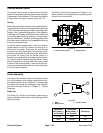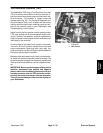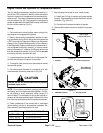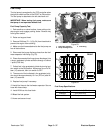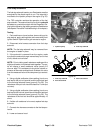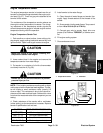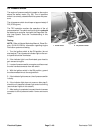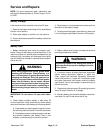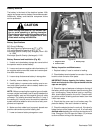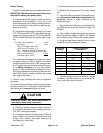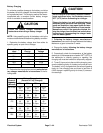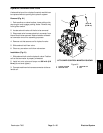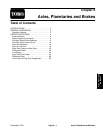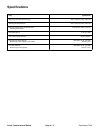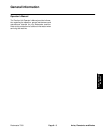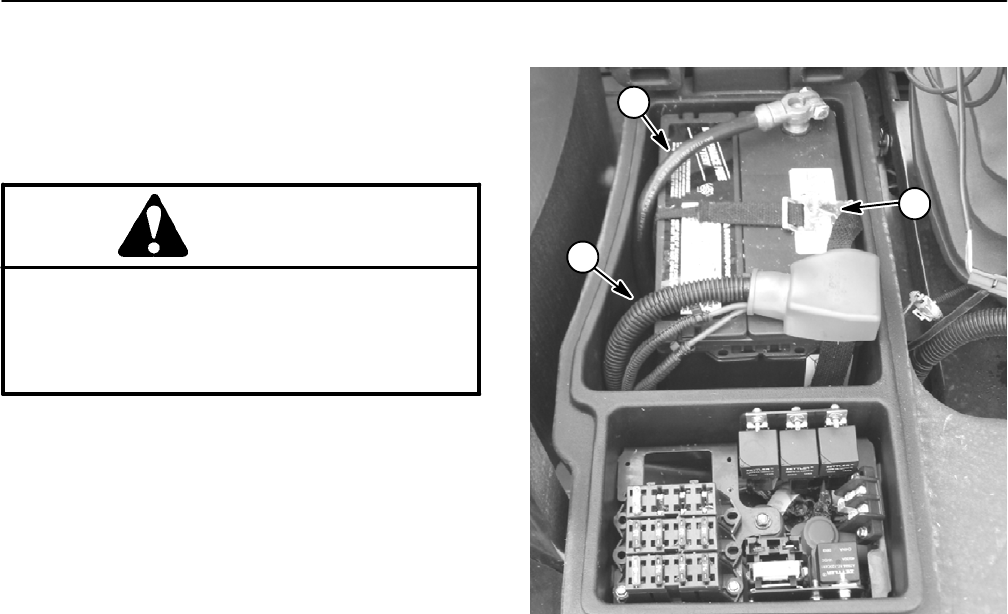
Reelmaster 7000Page 5 -- 42Electrical System
Battery Service
The battery is the heart of the electrical system. With
regular andproper service,battery lifecan be extended.
Additionally, battery and electrical component failure
can be prevented.
CAUTION
When working with batteries, use extreme cau-
tion to avoid splashing or spilling electrolyte.
Electrolyte candestroy clothing andburn skin or
eyes. Always wear safety goggles and a face
shield when working with batteries.
Battery Specifications
BCI Group 24 Battery
660 Amp Cranking Performance at 0
o
F(--18
o
C)
110 minute Reserve Capacity at 80
o
F(27
o
C)
Electrolyte Specific Gravity (fully charged): from 1.250
to 1.280
Electrolyte Specific Gravity (discharged): 1.240
Battery Removal and Installation (Fig. 60)
1. Unlatch and raise battery storage box cover behind
the operator seat to access battery.
2. Loosen and remove negative cable from battery. Af-
ter negative cable is removed, loosen and remove posi-
tive cable from battery.
3. Loosen strap that secures battery in storage box.
4. Carefully remove battery from machine.
5. Install battery in reverse order making sure to con-
nect and tighten positive cable to battery before con-
necting the negative cable.
NOTE: Beforeconnecting the negative (ground) cable,
connect a digital multimeter (set to amps) between the
negative battery post and the negative (ground) cable
connector. The reading should be less than 0.1 amp. If
the reading is 0.1 amp or more, the machine’s electrical
system should be tested for short circuits or faulty com-
ponents and repaired.
6. Make sure that rubber boot is properly placed over
positive cable end and positive battery post.
7. Lower and secure battery storage box cover.
1. Negative cable
2. Positive cable
3. Battery strap
Figure 60
2
1
3
Battery Inspection and Maintenance
1. Replace battery if case is cracked or leaking.
2. Check battery terminal posts for corrosion. Use wire
brush to clean corrosion from posts.
IMPORTANT: Before cleaning the battery, tape or
block vent holes to the filler caps and make sure the
caps are on tightly.
3. Check for signs of wetness or leakage on the top of
the battery which might indicate a loose or missing filler
cap, overcharging, loose terminal post or overfilling.
Also, check battery case for dirt and oil. Clean the bat-
tery with a solution of baking soda and water, then rinse
it with clean water.
4. Check that the cover seal is not broken away. Re-
place the battery if the seal is broken or leaking.
5. Check the electrolyte level in each cell. If the level is
below the tops of the plates in any cell, fill all cells with
distilled water between the minimum and maximum fill
lines. Charge at 15 to 25 amps for fifteen (15) minutes
to allow sufficient mixing of the electrolyte.



